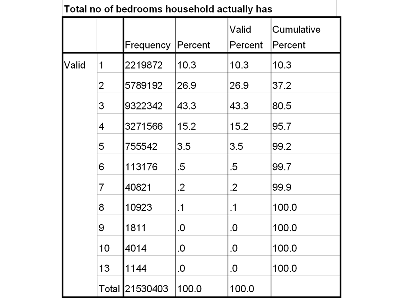Impact
Research ideas using housing data
Government surveys are routinely deposited with the UK Data Archive for reuse. The extent of information on housing and the local environment varies from dataset to dataset, but the files have certain features in common:
- these surveys are repeated on a regular basis and form part of a series which may allow comparisons over time to be made
- data are collected from private households and may include information on other household members, and the focus is on their homes and attitudes to their local environment
- the datasets contain information about individual characteristics that can be used flexibly, but which may need to be weighted to provide a representative sample
- data may be presented in multiple files which need to be merged together to create a useful dataset
What can a user do with the data?
Household surveys vary considerably in terms of the type of information collected on housing and the local environment. The Survey of English Housing (SEH) collected information about aspects of housing including tenure, housing history and attitudes to the local environment. It has been used by Fitzpatrick and Pawson (2007) to better understand the uptake of social housing. Kearns and Mason (2007) benefitted from having census data linked by postcode by the Office for the Deputy Prime Minister to the SEH data to consider the impact of the tenure mix in the respondent’s ward on their satisfaction with the neighbourhood concluding that mixing is not in itself as important as the proportion of social rented accommodation in an area.
The English House Condition Survey focused on housing quality as assessed by a physical survey of the property but also contained some subjective measures. Accordingly, Beresford and Rhodes (2008) were able to use the data to establish that in 2003-04 families with a disabled child were less likely to live in a ‘decent’ home (71.6%) than those who did not (76.2%). They were also less likely to be dissatisfied with the current state of repair of their home (30% of households with a disabled dependent child compared with 18% of those with a non-disabled dependent child).
Less detailed housing information in other surveys can also be used to good effect. Rutter and Latorre (2009) used data from the Labour Force Survey alongside Census data and focus group evidence to disprove claims that immigrant groups have received preferential treatment in social housing allocation. While the LFS contains less detailed housing information than the specialised surveys, it is routinely used to measure tenure as it benefits from a large sample size.
Using the English Housing Survey to predict census outcomes
The English Housing Survey (EHS) is a new survey which from 2008 combines the strengths of both the English House Condition Survey and Survey of English Housing; being composed of a household survey and, for a subset, a physical survey of the property. Information about the survey, including links to published reports can be obtained from the English Housing Survey web pages.
Household and housing conditions data are deposited separately. The household data are an excellent resource for finding out about the type of housing that people live in and an example of data use is given below.
A research team working on proposals for outputs from the 2011 Census needed to anticipate the distribution of the number of bedrooms per household in England. The EHS household data enabled the team to obtain weighted estimates of population counts for private households in England.
The steps taken were:
- the team registered to use the data
- a copy of the household file was obtained in zipped SPSS format
- after the team had consulted the documentation they opted to start exploring the data in the ‘derived’ files as these data have been cleaned and gaps in the data have been fixed

- the general file contains general household variables including the household weighting variable. Information about the number of bedrooms was available in the interview file. These were linked together using the merge files, add variables procedure in SPSS. The key variable was the household id variable aacode. The data were then weighted with the variable aagfh08
- once weighted, the results were presented as estimates of the number of households with each number of bedrooms in the population of England

- the team estimated that while 10% of the households in England have 1 bedroom, less than 1% of households have 5 or more bedrooms. This information was then used by the research team to assess the amount of detail that might be necessary in the variables on the 2011 Census microdata files
- although this was sufficient for the user’s needs, it would have been interesting and possible to look at the characteristics of households which are overcrowded
References:
Beresford, B. and Rhodes, D. (2008) Housing and disabled children, Joseph Rowntree Foundation, Retrieved from http://www.jrf.org.uk/publications/housing-and-disabled-children last accessed 8/3/11.
Fitzpatrick, S. and Pawson, H. (2007) ‘Welfare safety net or tenure of choice? The dilemma facing social housing policy in England’, Housing Studies, 22(2), pp.163-182.
Rutter, J and Latorre, M (2009) Social housing allocation and immigrant communities, Equality and Human Rights Commission Research Report 4 (Manchester)
